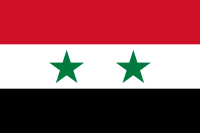User:Emmette Hernandez Coleman/Flag of the United Arab Republic
 | |
| Use | National flag and ensign |
|---|---|
| Proportion | 2:3 |
| Adopted | 22 February 1958, abandoned on 28 September 1961;readopted on 30 March 1980[1] |
| Design | A horizontal tricolour triband of red, white, and black, with two green stars charged in the centre. |

 flag of the United Arab Republic (1958-1971 - though Syria withdrew from the union in 1961, Egypt retained the official name until 1971)
flag of the United Arab Republic (1958-1971 - though Syria withdrew from the union in 1961, Egypt retained the official name until 1971)The flag of the United Arab Republic was a tricolour consisting of the three equal horizontal red, white, and black bands of the Arab Liberation flag dating back to the Egyptian Revolution of 1952. The flag bears Egypt's national emblem, the Eagle of Saladin centered in the white band.
In 1958, Egypt and Syria united as the United Arab Republic (U.A.R.) and adopted a national flag based on the Arab Liberation flag, with two green stars (representing the two countries of the union) replacing the Eagle of Saladin in the white band. A modified version of the Eagle of Saladin was adopted as the U.A.R.'s coat of arms.
The flag was adopted by Gamal Abd al-Nasser, president of Egypt and president of the United Arab Republic.[2] The stars on the flag were changed from red to green in order to restore the missing pan-Arab colour, with one star representing Egypt and the other Syria.[3] The flag was changed from the former independence flag in April 1958 along with associated laws designed to create a greater Arab identity.[2] After Syria left the UAR, President Nazim al-Kudsi continued to use the flag until 28 September 1961, when it was replaced by the independence flag to disassociate Syria from the failed union. The first flag of Syria to be adopted by its Revolutionary Command Council — following a Ba'athist coup d'état[4] — was adopted on 8 March 1963, and was used until 1 January 1972.[5] In 1963, the Ba'athist regime came to power in Iraq as well, and the two Ba'athis governments began negotiations in Cairo in order to once again form a union between Egypt, Syria and Iraq. The process failed after Iraqi Ba'athist government was overthrown in November 1963.[6] This flag was not much different from the flag of the UAR, with only a change from two stars to three, in order to represent the addition of Iraq to the Federation.[5] The three stars represented the unity of Egypt, Syria and Iraq, as well as three pilars of Ba'athism: unity, freedom and socialism.[7] President Hafez al-Assad adopted the new flag on 1 January 1972, as Syria joined Egypt and Libya in the Federation of Arab Republics. The green stars were replaced by the eagle of Quarish (the symbol of the tribe of the Prophet Muhammad). The eagle held the ribbon with name of the Federation, but unlike Egypt and Libya, Syria did not include its name on the coat of arms.[8] This flag was an official flag during the Yom Kippur War in 1973.[5] The Federation was dissolved in 1977, but Syria continued to use the flag for the next three years.[8] The flag was abrogated on 29 March 1980,[5] and replaced by the current flag[7] in order to show Syria's commitment to Arab unity.[5]
- ^ Ipavec, Eugene (17 March 2012). "Syria". Flags of the World. Retrieved 7 August 2012.
- ^ a b Podeh 1999, p. 120.
- ^ Mills, T. F. (10 March 2012). "Pan-Arab Colours". Flags of the World. Retrieved 24 November 2012.
- ^ King 2009, p. 41.
- ^ a b c d e "Syrian Flag". History of Syria. Retrieved 7 August 2012.
- ^ Goodarzi 2006, p. 14.
- ^ a b [better source needed]"العلم السوري" (in Arabic). Discover Syria. Retrieved 7 September 2012.
- ^ a b Cite error: The named reference
fotwwas invoked but never defined (see the help page).